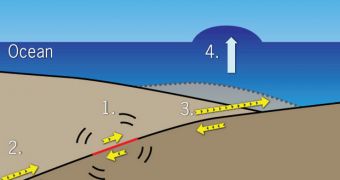An analysis conducted by researchers at the Stanford University, in the United States, reveals the reasons why the magnitude 9 earthquake that struck Japan on March 11 caused such a massive tsunami.
According to the investigators, the unusual fault lines located northeast of the capital Tokyo ruptured in a very unusual manner. This is partially what gave the event is strength, but also what contributed to the creation of the tremendously powerful tsunami waves.
Working together with colleagues from the University of Tokyo, the American scientists were able to determine that the fault rupture that generated the tremor first began by moving westward.
After a short period of time, movement in that direction stalled and stopped, while the rupture continued violently eastwards. This caused a “flip-flop” fault motion that was responsible for deforming a very large amount of seafloor sediments.
By pushing up vast amounts of such sediments, these seismic movements essentially caused a deformation in the surface of the water as well. The ripple wave then started moving towards the shoreline, where it eventually turned into a devastating tsunami.
“It was not appreciated before this earthquake that this size of earthquake was possible on this plate boundary. It was thought that typical earthquakes were much smaller,” explains Stanford geophysicist Greg Beroza.
Following the 1995 earthquake that struck Kobe, everybody in Japan and around the world was expecting the next big tremor to take place south of Japan, where the Philippines plate is pushing against the Japanese one.
“When the rupture approached the seafloor, it exploded into tremendously large slip. It displaced the seafloor dramatically,” the Stanford expert goes on to say.
“This amplification of slip near the surface was predicted in computer simulations of earthquake rupture, but this is the first time we have clearly seen it occur in a real earthquake,” Beroza adds.
“The depth of the water column there is also greater than elsewhere. That, together with the slip being greatest where the fault meets the ocean floor, led to the tsunami being outlandishly big,” he says.
Details of the new investigation were published in last week's online issue of the esteemed journal Science Express. Experts are now saying that they have to analyze similar subduction zones around the world.
The goal of these investigations will be to determine whether similarly-large earthquakes and tsunamis are possible at other locations as well. Funding for the new research came from the Japanese Society for the Promotion of Science.

 14 DAY TRIAL //
14 DAY TRIAL //